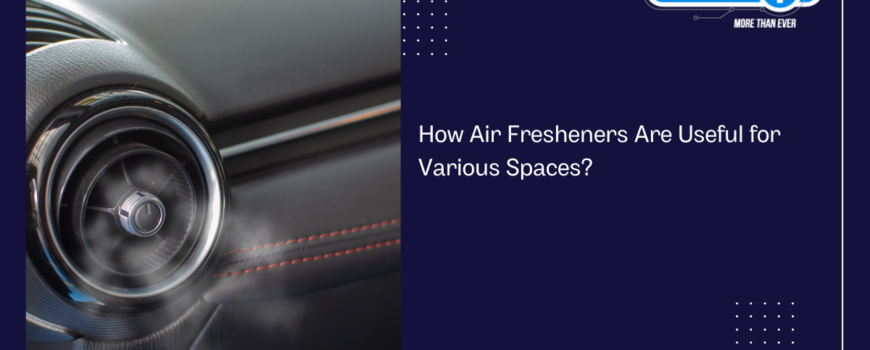We all recognize that smell is crucial to our sensory experience and is closely tied to memory and emotion. A pleasant smell can instantly lift our spirits, while unpleasant odours can have the opposite effect. This makes incorporating air fresheners into our daily lives incredibly beneficial. Using car air fresheners is an intelligent way to ensure pleasant smells in every space. Let’s look at how smell influences our mood and why air fresheners are a must to create that ambiance in any space.
Car Air Fresheners: Essential for Every Space
Your car is like your second home, especially if you spend a lot of time driving. Keeping it smelling fresh can make a big difference in your driving experience. Car Air Fresheners are designed to eliminate bad odours and introduce a pleasant scent, making every ride enjoyable. But the benefits of these fresheners aren’t limited to your vehicle. Their versatility means they can be used in any space that needs a refreshing touch.
1. Creating a Fresh Home Environment
Your home is where you unwind and relax after a long day. Air fresheners can create a calming and pleasant atmosphere. Consider these specific areas where car air fresheners can be used:
· Living Room: Use a mild, inviting fragrance to make your living room a welcoming space for family and guests.
· Kitchen: Combat strong cooking odours with fresh, clean scents like lemon or eucalyptus.
· Bathroom: Maintain a fresh and hygienic atmosphere with air fresheners to neutralize bathroom odours.
· Bedrooms: opt for soothing scents like lavender or chamomile to promote relaxation and better sleep.
· Pet Areas: Use air fresheners to neutralize odours where pets sleep or play, ensuring a pleasant environment for you and your furry friends.
2. Improving Office Spaces
In the office, a fresh-smelling environment can boost productivity and morale. Here’s how to use car air fresheners effectively in a work setting:
· Individual Desks: Personal air fresheners or small diffusers can create a pleasant personal space without overwhelming colleagues.
· Meeting Rooms: Fresh, clean scents can create a professional and inviting meeting atmosphere.
· Common Areas: Use air fresheners in break rooms and restrooms to ensure these shared spaces remain pleasant.
3. Revitalizing Shops and Malls
In retail environments, a fresh-smelling space can attract customers and improve their shopping experience. Use air fresheners in:
· Entrance Areas: A welcoming scent at the entrance sets a positive tone for shoppers.
· Sales Floors: Distribute pleasant fragrances to create an inviting atmosphere throughout the store.
· Restrooms: Maintain cleanliness and freshness in restrooms with effective air fresheners.
4. Creating a Pleasant Restaurant Environment
Maintaining a pleasant aroma is critical to customer satisfaction in restaurants and cafes. Use car air fresheners in:
· Dining Areas: Fresh, subtle scents enhance the dining experience without overpowering food aromas.
· Waiting Areas: Keep waiting areas inviting with pleasant fragrances.
· Restrooms: Ensure restrooms are fresh and clean with specialized air fresheners.
5. Keeping Gyms Fresh
A clean-smelling gym contributes to a more enjoyable workout experience. Use car air fresheners in:
· Workout Areas: Use fresh scents to deal with odours and create an environment positive to regular physical activity.
· Locker Rooms: Keep locker rooms smelling clean and fresh with air fresheners.
· Reception Areas: Create a welcoming environment
6. Creating a Welcoming Hotel Space
In hotels, a pleasant scent can significantly impact guest satisfaction. Use car air fresheners in:
· Guest Rooms: Use air fresheners to ensure rooms are always welcoming and fresh.
· Lobbies: Create an inviting atmosphere with pleasant fragrances in the lobby.
· Common Areas: Maintain freshness in hallways and lounges for a consistent guest experience.
· Laundry Room: Keep the laundry room smelling clean and fresh, masking any lingering odours from dirty clothes or cleaning products.
7. Enhance Patient Comfort in Hospitals
In healthcare settings, a clean, fresh-smelling environment can enhance patient comfort. Use air fresheners in:
· Waiting Rooms: Create a calming atmosphere with subtle, soothing scents.
· Patient Rooms: Ensure patient rooms smell fresh and inviting.
· Restrooms: Maintain a clean and hygienic atmosphere with effective air fresheners.
To Sum Up
Car air fresheners are handy and appropriate for any location. Choose air fresheners with a long-lasting aroma to avoid frequent replacements. Based on your preferences and convenience, choose between vent clips, gels, sprays, and hanging fresheners. Using air fresheners that filter the air may reduce allergens and pollutants, creating a healthier environment.




